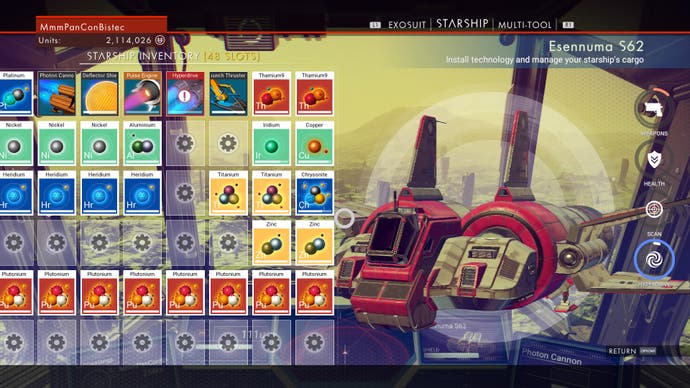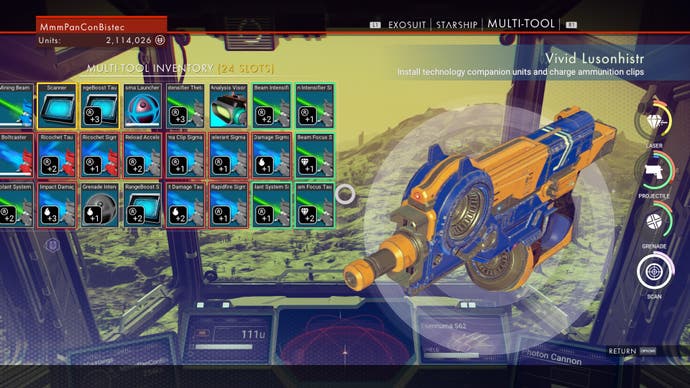You can max out your ship and equipment on the first planet in No Man's Sky
Someone's done it.
Reddit user DoktorFeelgood has "maxed out" the starship, exosuit and multi-tool without leaving the starter planet No Man's Sky - proving some interesting things about the way the game systems work in the process.
"I've spent 25+ hours on my starter planet and have maxed out my Exo Suit, Starship, and Multi-tool. I think I'm ready to begin my journey," DoktorFeelgood posted, with screenshots of his three inventory screens to prove it.

By "maxed out", the poster means that the maximum inventory space on each item has been attained: 24 slots on the multi-tool, and 48 each on the starship and exosuit. Every player will know that inventory space is the most precious commodity in No Man's Sky. But as you can see from the screenshots, DoktorFeelgood doesn't have many upgrades installed, reasoning in the thread that the plan for this phase of their game was to keep as much space as possible for hauling materials (upgrades take up inventory space in No Man's Sky): "This set up was to maximize grinding/hauling. I would even scrap upgrades that crashed ships already had."
Upgrades would be particularly difficult to create without leaving the first planet, since many of them require exotic resources, and you would be limited to the materials you can find on that world or trade for (usually in small quantities) at terminals. Nevertheless, the Redditor's feat is quite an achievement. Upgrades to the exosuit's inventory space are bought at considerable cost, as are better multi-tools, while bigger starships must be salvaged and repaired, or bought in trade. DoktorFeelgood ground out currency units for buying upgrades by mining and selling large amounts of gold, which was present on the planet, and improved the vessel by hunting for starship wrecks: "Finding crashed ships is the way to go." The latter was achieved by flying around looking for the easy-to-spot transmission tower buildings that detect the distress signals of crashed ships.

As well as being impressive, the feat proves that progress through the game's equipment tiers is in no way linked to exploration of the galaxy, and likely has no relation to the game's milestone progression system either (since many of these cannot be advanced without exploring space or multiple planets). It seems the quality of multi-tool and starship finds is linked to what you have equipped, with progress by one or maybe two slots at a time being the norm - and that these finds will continue to be generated, regardless of your location.
Technology blueprint drops seem to be completely random as well as being location-independent - DoktorFeelgood claims unknown blueprints were a rare find by the end of the 25 hours. That includes the first Atlas Pass, which was previously thought to be exclusive to your first encounter with the Space Anomaly, but the Redditor found one planetside.

DoktorFeelgood only met one sentient alien race on the planet - the Gek - but did get close to learning all the available words in the Gek language. It was a low-security planet, so the sentinel robots weren't hostile, but the Redditor had to deal with constant acid rain.
With upgrading your equipment being a primary motivator in the game DoktorFeelgood has, in a way, completed No Man's Sky without really playing it. A strange way to play the game? Maybe, but imagine exploring No Man's Sky's galaxy without fretting about inventory space. And note the genuine freedom and openness of the game's systems, which allow you to progress in any way you want. For more, check out our full No Man's Sky guide and final No Man's Sky review.








